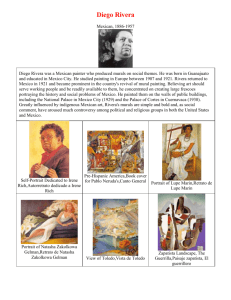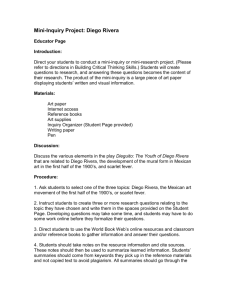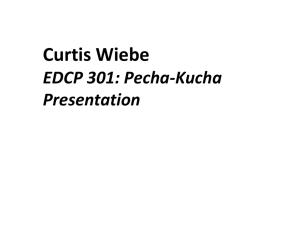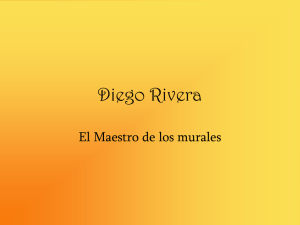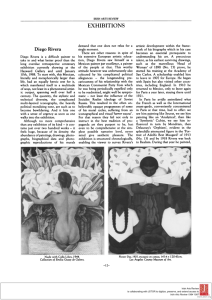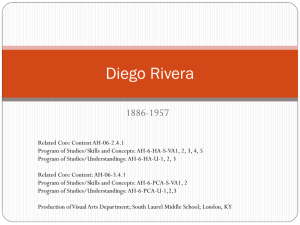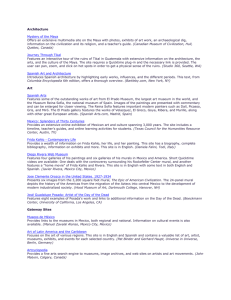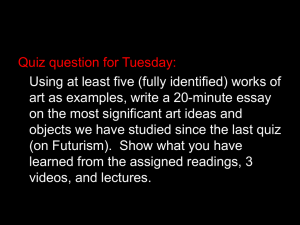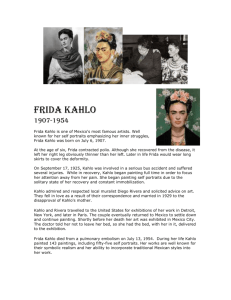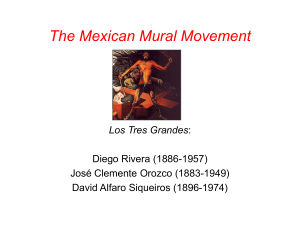Diego Rivera
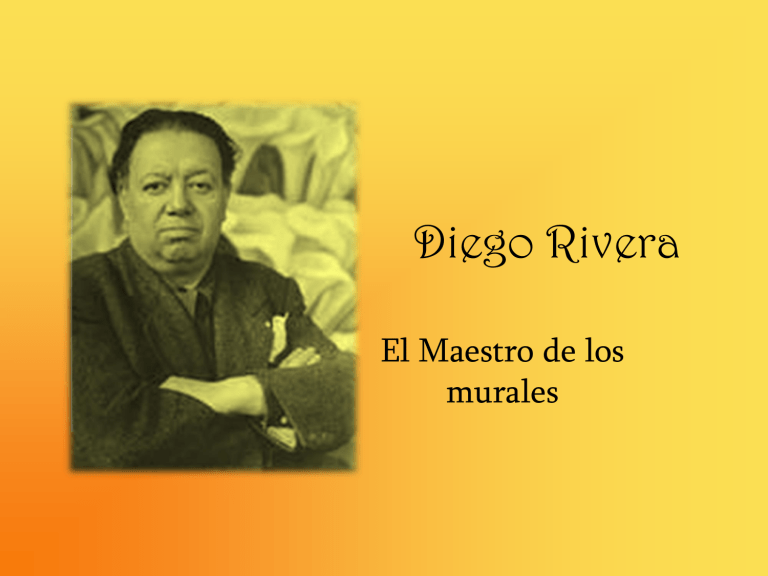
Diego Rivera
El Maestro de los murales
Who was Diego Rivera?
Diego at the age of 5 .
Diego Rivera (1886-1957) was one of Mexico's most important painters and a major artist of the twentieth century. Born on December
8, 1886 in Guanajuato,
Rivera studied traditional
European artistic styles at the Academia de San Carlos in Mexico City.
Rivera combined this classical training with the influence of Mexican folk artist Jose
Guadalupe Posada, emerging as an accomplished painter with a distinctly Mexican style by the age of sixteen.
Las murallas
Influenced by the Mexican Revolution
(1914-15) and the Russian Revolution (1917),
Rivera believed that art should play a role in empowering working people to understand their own histories. He did not want his art to be isolated in museums and galleries, but made accessible to the people, spread on the walls of public buildings.
To this end, Rivera traveled to Italy to study early
Renaissance fresco. true fresco is very permanent and consists of brush painting onto freshly applied, wet lime plaster. Using water as the medium the paint is absorbed into the plaster as it dries and the pigment is bound into the structure of the plaster.
When he returned to Mexico, he was ready to formulate his own style of public paintings that would speak directly to the working and indigenous peoples of Mexico.
In 1907
Rivera traveled to
Spain to study the works of
Goya, El
Greco, and
Brueghel at
Madrid's
El Prado museum..
Maternidad, 1916
Later he moved to Paris and became fascinated with the avante-garde
Cubist movement which
Pablo Picasso founded.
After 4 years devoted to
Cubism, Rivera began to question the movement.
Maternity, oil on canvas, cubism 1916
Woman at the Well
Oil on canvas cubism
1913
The Architect
Oil on canvas cubism
1914
La Creación, 1921-1923
Fresco mural, Mexico City,
Simon Bolivar amphitheater, main wall
La Molendera
, 1924
Oil on canvas
Museo de Arte Moderno, INBA, Mexico City
Los Explotadores
, 1926
Fresco Mural
Universidad Autonoma de Chapingo Chapel, west Wall
Blood of the revolutionary martyrs fertilizing the earth , 1926
Fresco Mural
Universidad Autonoma de Chapingo Chapel, east Wall
Su Esposa
Diego Rivera and Frida
Kahlo were married on August 19, 1929
Diego was 42, 6’ tall and 300 lbs
Frida was 22, 5’3” tall and 98 lbs
He was 21 years older than Frida.
Historia de México - El antiguo Mundo
Indígena, 1929-1935
The Indigenous World,
1923-1924, 1929-1935,
Fresco Mural
Mexico City,
National Palace,
North Wall
Some of his artworks were controversial; his “
Man at the
Crossroads” in New
York City's RCA building, which featured a portrait of
Vladmir Lenin, was stopped and destroyed by the
Rockefeller family.
The painting was roughly divided into two sections. The left panel showed elite people, a contrast was reflected on the other side with a group of people protesting and being clubbed by the police.
Man at the crossroads
, 1934
Man at the Crossroads, 1934
Fresco mural
Museo del Palacio de Bellas Artes, Mexico City
The work was paid for on May 22, 1933 and immediately draped. People protested but it remained covered until the early weeks of 1934, when it was smashed by workers and hauled away in wheelbarrows.
http://www.youtube.com/watch?feature= player_embedded&v=VBojWKSMNtc
Cargador de Flores, 1935
"
Rivera believed that art should play a role in empowering working people to understand their own histories."
Oil and tempera on Masonite
San Francisco Museum of Modern Art
Vendedora de Flores
, 1949
Oil on canvas
Museum of Contemporary Art, Madrid Spain
Retrato de Dolores Olmedo
, 1955
Portrait of Dolores Olmedo, 1955
Oil on canvas
Museum Dolores Olmedo Patiño, Mexico City
Dream of a Sunday afternoon in Alameda Park
If you visit Mexico City you don’t want to miss this mural by Diego Rivera that he painted in 1947.
It measures 45-feet long and 14-feet high.
Originally it was in the vestibule of the Hotel Del
Prado . The 1985 earthquake destroyed the hotel but not the mural, and this museum was built across the street from the hotel's site to house it.
A Dream of a Sunday Afternoon in Alameda Park
,
1947-48
Fresco, Alameda Hotel, Mexico City
Now located in the Diego Rivera Museum
It depicts the history of the park as Diego recalled it in his childhood and mentions many historic references to it. We see Diego’s self portrait as a child strolling through the park holding the hand of a “Catrina” (Death) while dreaming of a perfect love,
(Frida Kalo standing behind him.)
Also in the painting is Jose Marti, father of
Cuban independence (tipping his hat), Jose
Marti lived in Mexico for about a year, he was well known in the literary society as a poet. He wrote the words to the song,
“Guantanamera”. The “Catrina” (Death) immortalized by the painter Jose Posadas, standing to the right, wears a boa of feathers shaped like a snake, prehispanic symbol of the plumed serpent, “Quetzalcoatl”.
Standing behind Posadas is Ricardo Magon, liberal writer who was against the dictator Porfirio
Diaz. He was forced out of the country but kept writing against the tyranny of Diaz and was persecuted even in the
U.S., he died in prison in the United States.
Girl with
Callas,
1944
Oil on canvas
May Day
Procession in
Moscow, 1956
Oil on canvas
“Only why do the artists of this continent think that they should always assimilate the art of
Europe? They should go to the other Americas for their enrichment, because if they copy
Europe it will always be something they cannot feel because after all they are not
Europeans.”
- Diego Rivera
Pan-American Unity mural for
San Francisco City College, 1940
Su muerte
In addition to being a celebrated and controversial artist, Diego Rivera was also a provocative political activist who incited debate not only in Mexico, but also in the
USA and the Soviet Union. Since his death in 1957 (at the age of 70), his hundreds of public artworks, his many oils and watercolors, and his political daring continue to contribute to the development of public art across the Americas.
Bibliography
For more information about Diego Rivera and the works presented here, go to: http://www.biography.com/people/diegorivera-9459446/videos/diego-rivera-minibio-17726164 http://www.riveramural.org/rivera/home.html
